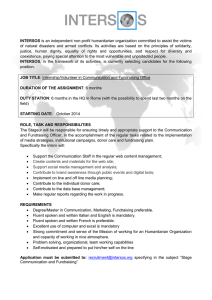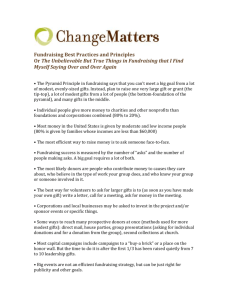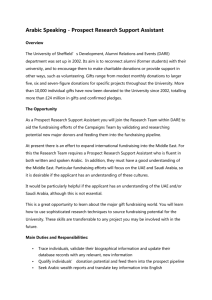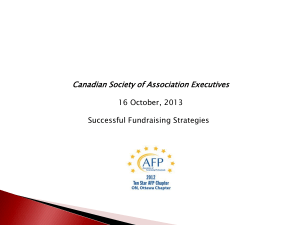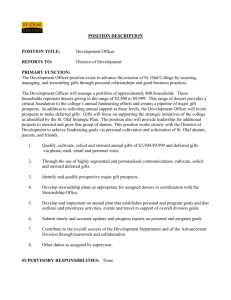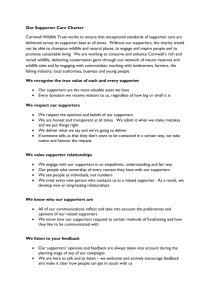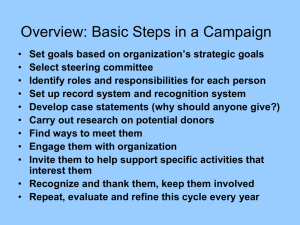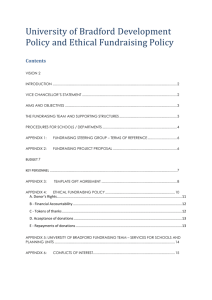Creating Your Fund Development Plan
advertisement
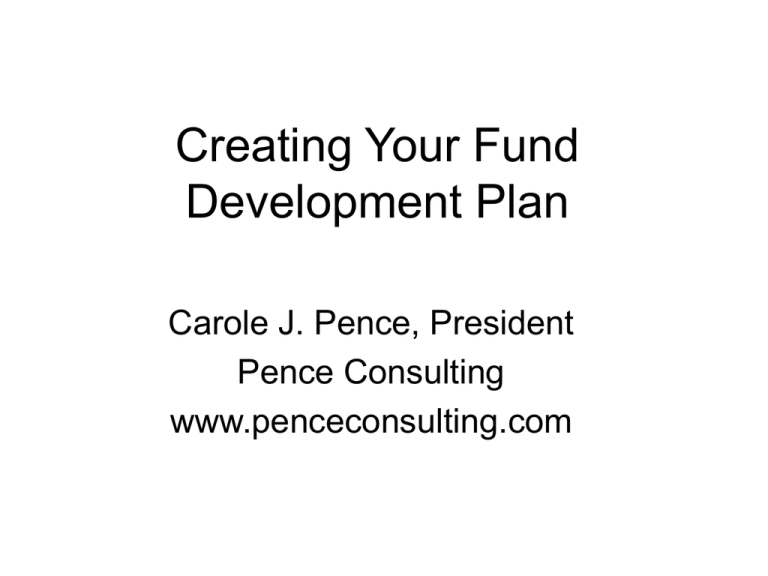
Creating Your Fund Development Plan Carole J. Pence, President Pence Consulting www.penceconsulting.com Planning Sequence For Fundraising 1. 2. 3. 4. 5. 6. 7. 8. 9. Gather facts. Determine and validate needs. Consider/evaluate markets Consider vehicles. List and evaluate resources. Select appropriate vehicles. Determine goals. Prepare plan. Install and use control mechanisms. Benefits of Planning • Improve performance. • Stimulate forward thinking. • Clarify future direction. • Solve major organizational problems. • Survive—even flourish—with less. • Build teamwork and expertise. • Influence rather than be influenced. • Meet others’ requirements. LIMITATIONS OF PLANNING • Costs can outweigh benefits. • When “life-threatening” problems should be addressed first. • When implementation is unlikely. • When poor plans are likely and intuition might be better. Writing the Plan Annual Fund Plan 200__ Prepared by: List Committee Approved by: Board of Trustees Cover Page Mission Statement Begin with reviewing your mission statement. Philanthropic Vision Statement of desired future role of philanthropy and how you intend to achieve it. Imagine where you want to take the fundraising program in the new few years, in light of your organizations mission and needs. Mini Case for Support • The unique benefits the organization provides to the community. • What, at this point is especially exciting, cutting edge, or promising. • Connections to traditions and organizational accomplishments of the past. • The compelling nature of the current organizational goals and initiatives. SWOT ANALYSIS • Strengths • Weaknesses • Opportunities • Threats Fundraising Goal 1. What are you going to raise money for? 2. Why is the money needed? 3. What will the funds accomplish? 4. How much do you need to raise Gift Range Chart $20,000 Gift Range $ 1,500 Cumulative # of Gifts # of Gifts 2 10 (5:1) Prospects# 10 $ per Range 3,000 Cumulative 3,000 750 4 20 (5:1) 30 3,000 500 12 48 (4:1) 48 6,000 12,000 250 24 66 (3:1) 72 6,000 18,000 $100 And under Many Gifts 6,000 2,000 20,000 Gift Range Chart $60,000 Goal Constituency Model TFRS © 2006-b PTF Overheads Financial Projects • Individuals • Corporations • Foundations • Special Events • Other Strategies for the Fundraising and Solicitation Plans Outline fundraising methods and match them to the constituencies from which you will raise funds. •project purpose, status, and strategies, •mini-case for support, •constituency goals, •project goals, objectives, methods, performance measures, and action steps, •staff and volunteer roles and responsibilities •project schedule and timelines. Fundraising Budgets: Income and Expense by Program In this section you will include budgets •Income and expense budget by program. •A fundraising income and expense budget by source/market. •The organization’s budget shows all income sources, including the amount projected from fundraising by program. Budget Items • • • • • • • • • Veterinary Care Food and Supplies Pull Fees Staff and Benefits Facility Overhead Insurance Cost Equipment Cost Transport Cost Community Costs Organizational Infrastructure • By taking some of your members off the front line and forming this fundraising committee will be a new approach. • Fundraising Committee to deal with the financial future. • Board and leadership buy-in. • Bigger organizations already have committees, look at what exists. Communication and Evaluation • Share the plan, get feedback and buy-in, revise the plan, and then circulate it and put it into use and raise money. Communication and Evaluation • You need to have a plans for acknowledgment of gifts. • Develop donor reports. • Do you have any recognition of donors. recognition activities, and site visits for each constituent group?

